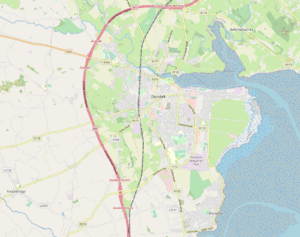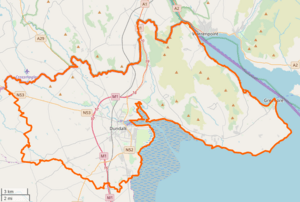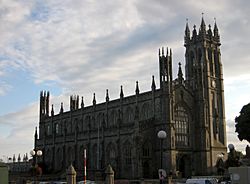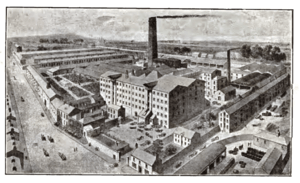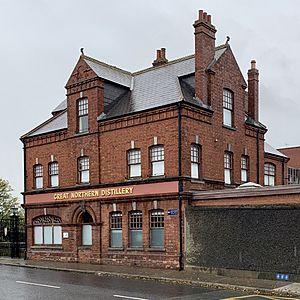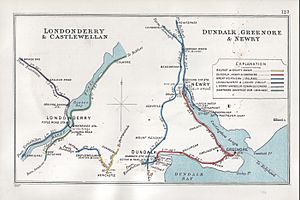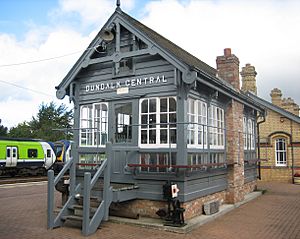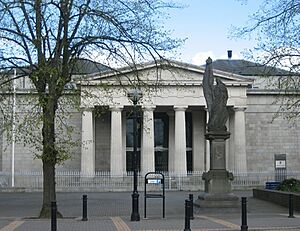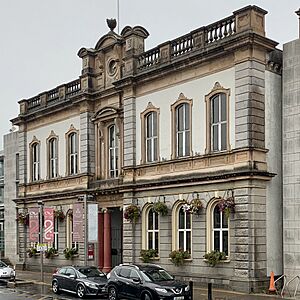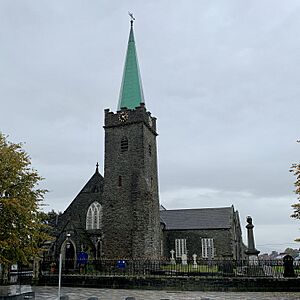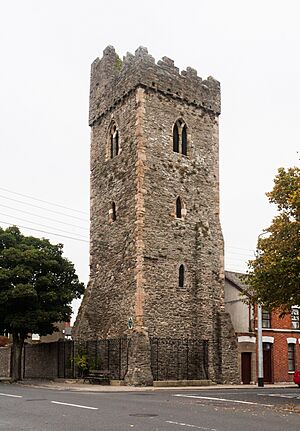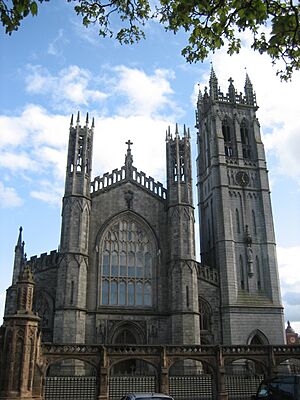Dundalk facts for kids
Quick facts for kids
Dundalk
Dún Dealgan
|
||
|---|---|---|
|
Town
|
||
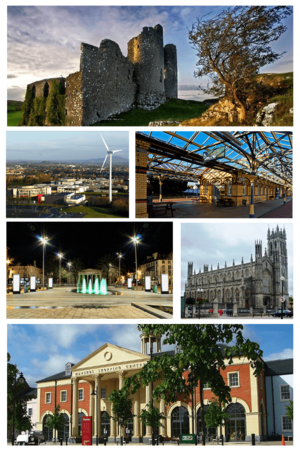
Clockwise from top: Castle Roche, Clarke Station, St. Patrick's Church, The Marshes Shopping Centre, Market Square, Dundalk Institute of Technology
|
||
|
||
| Motto(s):
Irish: Mé do rug Cú Chulainn cróga
'I gave birth to brave Cú Chulainn' |
||
| Country | Ireland | |
| Province | Leinster | |
| County | County Louth | |
| Inhabited | c. 3700 BC | |
| Charter | 1189 AD | |
| Area | ||
| • Urban | 21.7 km2 (8.4 sq mi) | |
| • Rural | 320.8 km2 (123.9 sq mi) | |
| Population
(2022 census)
|
||
| • Rank | 7th | |
| • Urban | 43,112 | |
| • Metro | 64,287 | |
| Time zone | UTC±0 (WET) | |
| • Summer (DST) | UTC+1 (IST) | |
| Eircode routing key |
A91
|
|
| Telephone area code | +353(0)42 | |
| Irish Grid Reference | J048074 | |
Dundalk (pronounced dun-DAWK) is a lively town in County Louth, Ireland. It's the main town of the county. Dundalk is located on the Castletown River, which flows into Dundalk Bay on Ireland's north-east coast. It's special because it's halfway between Dublin and Belfast, very close to the border with Northern Ireland.
The town is surrounded by many smaller areas and villages that together form the wider Dundalk Municipal District. It is the seventh largest urban area in Ireland. In 2022, about 43,112 people lived here.
Dundalk has a very long history, with people living here since the Neolithic period (around 3700 BC). It became a stronghold for the Normans in the 12th century. Later, it was the northernmost point of an area called The Pale in the Late Middle Ages. Because of its location where the province of Leinster meets Ulster, it was known as the "Gap of the North."
The way the streets are laid out today mostly comes from the early 1700s. This was planned by James Hamilton, who later became the 1st Earl of Clanbrassil. Dundalk is also famous for the stories of the mythical warrior hero Cú Chulainn. The town's coat of arms even has a motto in Irish: Mé do rug Cú Chulainn cróga, which means "I gave birth to brave Cú Chulainn."
In the 1800s, Dundalk became a busy place with industries like brewing, making spirits, tobacco, textiles, and engineering. It grew into an important center for making and trading goods. This was helped by its connection to the Great Northern Railway (Ireland) and its port, which linked it to Liverpool. After the Partition of Ireland in 1921 and Ireland joining the European Economic Community in 1973, some of these older industries closed. This led to job losses.
However, in the early 2000s, new types of businesses came to Dundalk. These include companies in medicine, technology, financial services, and special foods.
Dundalk has a third-level college, Dundalk Institute of Technology. The biggest theatre, An Táin Arts Centre, is in Dundalk Town Hall. It's named after a famous Irish myth. You can also find the County Museum Dundalk and the Louth County Library in the old Dundalk Distillery buildings.
For sports, Dundalk has many clubs. These include Dundalk Football Club (who play at Oriel Park), Dundalk Rugby Club, and several Gaelic games clubs. Dundalk Stadium is a unique place where you can watch horse and greyhound racing. It's Ireland's only all-weather horse racing track.
Contents
- History of Dundalk
- Geography and Climate
- People of Dundalk (Demography)
- Economy: How Does Dundalk Make Money?
- Getting Around Dundalk (Transport)
- Dundalk's Buildings and Spaces (Architecture)
- Learning in Dundalk (Education)
- Culture and Fun in Dundalk
- Twin Towns
- Sports in Dundalk
- Media and News
- See also
History of Dundalk
Dundalk has been home to people for a very long time, since at least 3500 BC. A cool reminder of these early people is the Proleek Dolmen, a very old stone tomb near Dundalk. Around 500 BC, Celtic culture arrived in Ireland. Legends say that a group called the Conaille Muirtheimne settled in North Louth. Their land now covers the Dundalk area.
Dundalk started as a simple village without walls. Its main streets followed a gravel path that is now Bridge Street, Church Street, Clanbrassil Street, Earl Street, and Dublin Street.
In 1169, the Normans came to Ireland and began to take over land. By 1185, a Norman nobleman named Bertram de Verdun built a manor house and got a special permission (a charter) for the town in 1189. Another Norman family, the De Courcys, settled in the Seatown area. Both families helped build walls and defenses, making Dundalk a Norman fortress. The town grew because it was near an easy place to cross the Castletown River. It was also a frontier town, marking the northern edge of The Pale. In 1236, Bertram's granddaughter, Rohesia, ordered Castle Roche to be built to protect the area from the Irish territory of Ulster.
In 1315, the town was attacked during the Bruce campaign. Edward Bruce took over Dundalk and even declared himself King of Ireland. He stayed for almost a year before his army was defeated and he was killed by John de Birmingham.
For many centuries, Dundalk was controlled by Royalist forces. But in 1647, it was taken over by Colonel George Monck's Northern Parliamentary Army.
The modern look of Dundalk largely comes from Lord Limerick (James Hamilton) in the 1600s. He planned new streets leading to the town center, inspired by his travels in Europe. He had the old walls and castles taken down and new roads built. One important new road connected the Market Square to a linen factory.
In the 1800s, Dundalk became more important. Many industries started, including a large distillery. This growth was helped by new railways, the expansion of the docks (the 'Quay'), and a group of commissioners who managed the town.
The partition of Ireland in May 1921 made Dundalk a border town. The main railway line between Dublin and Belfast became an international route. Customs checks were set up in Dundalk for goods and people crossing the border by train. The Irish Civil War (1922–23) also saw some fighting in Dundalk.
For decades after the Civil War, Dundalk remained a market town and a center for business and manufacturing. Its location near the border made it important during the period known as the "Troubles" in Northern Ireland. Dundalk even got the nickname 'El Paso', like the Texan border town.
In 1973, the 27th Infantry Battalion of the Irish Army was set up in Dundalk barracks. In 1986, it was renamed Aiken Barracks.
Dundalk faced economic challenges when Ireland joined the European Economic Community in the 1970s. Local businesses found it hard to compete with foreign companies. However, today many international companies have factories in Dundalk, making everything from food to computer parts. For example, Harp Lager beer is brewed at the Great Northern Brewery.
In 2006, the Earl of Roden, whose family had owned land in Dundalk for over 300 years, sold his property interests in the town.
Dundalk's Coat of Arms
The town's coat of arms features a diagonal stripe (called a bend) and six small birds (called martlets). These symbols come from the family of Thomas de Furnivall, who gained much land in Dundalk around 1309. Three of these martlets are also on the badge of Dundalk FC. The boar (a wild pig) supporting the shield comes from the arms of the Ó hAnluain (O'Hanlon) family, who were kings of Airthir.
Geography and Climate
What is Dundalk's Landscape Like?
Dundalk is located where the Castletown River flows into Dundalk Bay. It's very close to the border with Northern Ireland, only about 3.5 kilometers away. The town is also roughly the same distance from both Dublin and Belfast.
What is the Climate in Dundalk?
Like most of northwest Europe, Dundalk has a maritime climate. This means it has cool winters and mild summers, without extreme temperatures. The town is protected by the Cooley and Mourne Mountains to the north, and rolling hills to the west and south.
| Climate data for Dundalk (2013-2015 averages) | |||||||||||||
|---|---|---|---|---|---|---|---|---|---|---|---|---|---|
| Month | Jan | Feb | Mar | Apr | May | Jun | Jul | Aug | Sep | Oct | Nov | Dec | Year |
| Record high °C (°F) | 14 (57) |
15 (59) |
16 (61) |
23 (73) |
23 (73) |
30 (86) |
29 (84) |
24 (75) |
24 (75) |
22 (72) |
17 (63) |
16 (61) |
30 (86) |
| Mean daily maximum °C (°F) | 12 (54) |
11 (52) |
12 (54) |
14 (57) |
17 (63) |
20 (68) |
23 (73) |
18 (64) |
17 (63) |
17 (63) |
12 (54) |
13 (55) |
15.5 (59.9) |
| Daily mean °C (°F) | 6.0 (42.8) |
6.0 (42.8) |
8.0 (46.4) |
11.0 (51.8) |
12.0 (53.6) |
16.0 (60.8) |
18.0 (64.4) |
15.0 (59.0) |
16.0 (60.8) |
11.0 (51.8) |
8.0 (46.4) |
7.0 (44.6) |
11.2 (52.2) |
| Mean daily minimum °C (°F) | 0.0 (32.0) |
1.0 (33.8) |
3.0 (37.4) |
8.0 (46.4) |
11.0 (51.8) |
13.0 (55.4) |
14.0 (57.2) |
12.0 (53.6) |
13.0 (55.4) |
7.0 (44.6) |
4.0 (39.2) |
0.0 (32.0) |
7.2 (45.0) |
| Record low °C (°F) | −4.0 (24.8) |
−4.0 (24.8) |
−2.0 (28.4) |
−2.0 (28.4) |
2.0 (35.6) |
7.0 (44.6) |
7.0 (44.6) |
5.0 (41.0) |
7.0 (44.6) |
2.0 (35.6) |
−1.0 (30.2) |
−5.0 (23.0) |
−5.0 (23.0) |
| Source: Dundalk ILOUTHDU4 Private Weather System, | |||||||||||||
People of Dundalk (Demography)
Dundalk is the seventh largest urban area in Ireland. It's the second largest town after Drogheda. In 2022, its population was 43,112. Dundalk is the biggest town in County Louth. The wider municipal district has a population of 64,287.
What Languages are Spoken in Dundalk?
Most people in Dundalk speak English as their first language. About 4% of the population speak the Irish language daily, outside of school. The Omeath area, within the municipal district, used to be a small Gaeltacht (Irish-speaking area). The last person who spoke the local 'Louth Irish' dialect passed away in 1960.
Economy: How Does Dundalk Make Money?
Industries in Dundalk
Linen was the first industry in Dundalk in the mid-1700s, but it didn't last. In the 1800s, new industries started, like mills, tanneries, a foundry, a distillery, and several breweries. The Port of Dundalk was also set up and became the eighth largest in Ireland for exports.
In the second half of the 1800s, Dundalk's population grew by 30% because its industries were doing so well. The Malcolm Brown & Co. Dundalk Distillery started around 1780. Brewing was also very important, with eight breweries by the late 1830s. After the famine of the 1840s, only two breweries remained, which then joined to form Macardle Moore & Co. The Great Northern Brewery opened later in 1896.
The Dundalk Iron Works began in 1821 and became a major employer. The P.J. Carroll tobacco factory also grew a lot. The Great Northern Railway (Ireland) works, started in 1881, became a huge part of the town's economy.
After the partition of Ireland, Dundalk's industries faced challenges. Taxes and customs checks at the border affected trade. The iron works and the distillery were among the first major local industries to close.
However, the town's industries recovered by 1950. The breweries were successful, and tobacco, shoe manufacturing, and the railway works provided thousands of jobs. Dundalk was a busy commercial center. But when the Northern Ireland government closed many railway lines, the G.N.R. company became unprofitable and closed in 1958. A new company, Dundalk Engineering Works Ltd (DEW), was set up to keep workers employed. Carroll's tobacco factory also expanded, opening a new, award-winning factory in 1970.
In the 1970s and 1980s, many businesses struggled when Ireland joined the European Economic Community (EEC) in 1973. The Engineering Works closed in 1985, and the last shoemaking factory closed in 2001. The ECCO factory, which once employed about 1,500 people, closed in 2006. Diageo closed both of the town's breweries, and the Carroll's factory closed in 2005.
Unemployment in Dundalk reached 27.9% by 1991. The town was slow to benefit from the "Celtic Tiger" economic boom in Ireland. By 2012, it was seen as one of Ireland's "most deprived areas" after the global financial crisis.
But things started to improve. The Great Northern Brewery reopened as 'the Great Northern Distillery' in 2015. New businesses, especially in technology and medicine, have also come to Dundalk.
Tourism in Dundalk
The Dundalk and North Louth area is part of the 'Ireland's Ancient East' tourism campaign. This campaign focuses on Ireland's rich history and heritage.
Louth is called the 'Land of Legends'. This campaign highlights the area's ancient history and aims to bring more visitors. Dundalk is home to Ireland's tallest mural, which shows the warrior god Lugh. It's on the Gateway Hotel and is 41 meters tall!
Getting Around Dundalk (Transport)
Shipping and the Port
Dundalk Port is used for importing and exporting goods. There are no passenger services. Shipping services to Liverpool started in 1837. The Dundalk and Newry Steam Packet Company used to ship cargo, animals, and passengers. This service continued until 1968.
Railway Connections
Dundalk has the closest train station to the border on the southern side of the Belfast–Dublin line. The first railway lines arrived in 1849. By 1860, you could travel northwest to Derry by train.
In 1876, many lines, including the Dublin and Belfast and Dundalk lines, became part of the Great Northern Railway (Ireland) (G.N.R.). After the partition of Ireland, the G.N.R. network crossed the border many times. By the 1950s, the G.N.R. was no longer making money and closed in 1958. This meant Dundalk lost its secondary train routes.
Today, Dundalk only has one main train line: the Dublin–Belfast "Enterprise" service, plus local commuter trains to Dublin.
The current Dundalk railway station was built by the G.N.R. in 1894. It was renamed Clarke Station in 1966, honoring Tom Clarke, a leader of the Easter Rising. The station has a small museum and is known as "the finest station on the main Dublin–Belfast line." It was even used as a filming location for the Walt Disney Pictures movie, Disenchanted, in 2021.
Bus Services
Dundalk's Bus Station is run by Bus Éireann. It's located near the town center. The company operates a local town bus service (Route 174). It also has routes from Dundalk to Dublin, Galway, Newry, and other towns.
A bus route between Dundalk and Blackrock has been operated by Halpenny Travel since 1920.
Road Network
The M1–N1/A1 connects Dundalk to Dublin and Belfast. There are three exits for Dundalk from the M1. Other important roads connect Dundalk to nearby towns and areas like the Cooley peninsula, Ardee, Armagh, and Virginia, County Cavan.
Dundalk's Buildings and Spaces (Architecture)
Many of Dundalk's beautiful buildings were built in the 1800s. Some buildings near the Market Square have a special "Dundalk style." These are ornate buildings that show how confident and successful the town's merchants were in the late 1800s.
The Dundalk Courthouse (finished in 1819) was designed to look like the Temple of Hephaestus in Athens. The Maid of Erin statue, put up in 1898, stands in front of the Courthouse. The nearby Town Hall (finished in 1865) is a grand building that now houses An Táin Arts Centre. This center has a main theatre, a smaller studio theatre, an art gallery, and workshop spaces.
The Kelly Monument is in Roden Place, near St Patrick's Church. It remembers Captain James Joseph Kelly and three volunteers who drowned trying to rescue a ship's crew in Dundalk Bay in 1858. The Louth County Library and the County Museum Dundalk are in restored buildings that used to be part of the Dundalk Distillery.
Dundalk Gaol (a jail) was finished in 1855 and closed in the 1930s. The Governor's House at the front became the Garda (police) Station. The old prison wings were later restored and now house the 'Oriel Centre' and the Louth County Archive.
The two oldest buildings in the town center are Saint Nicholas's Church of Ireland church and Seatown Castle. Saint Nicholas's was built around 1400. It's known locally as the Green Church because of its green copper spire. The poet Robert Burns's sister, Agnes Burns, is buried in its graveyard. Seatown Castle is part of what was a Franciscan friary from the 1200s.
Further from the town center are Dún Dealgan Motte and Castle Roche. Dún Dealgan Motte is also called Cú Chulainn Castle. It's a national monument on the site of a manor house built by Bertram de Verdun. Castle Roche was built by Bertram's granddaughter, Roesia, in the late 1200s.
A modern building that has won awards is the Carroll's tobacco factory on the Dublin Road. It's known for its unique design. It became part of the Dundalk Institute of Technology campus.
Many of the town's churches were also built in the 1800s. These include the Presbyterian church (1839) and several Roman Catholic churches like St Patrick (1847). St Patrick's was designed to look like King's College Chapel, Cambridge.
Public Spaces to Enjoy
The largest park in the town center is Ice House Hill. It's about 8 hectares in size. The original Ice House, built around 1780, is still there. St. Helena Park is a smaller park, about 0.7 hectares, first laid out in the 1800s. St Leonard's Garden in Seatown is a small park with ruins of stone walls from a 12th-century friary.
The Navvy Bank is a long walkway, about 2 kilometers long. It was built in the 1840s to help ships get to Dundalk Port. Now it's a public path. Along the way, there's a memorial to those who died when the S.S. Dundalk sank in World War I. At Soldiers Point, you can see a bronze sculpture called The Sea God Managuan and Voyagers.
Next to Dundalk is the village of Blackrock, about 5 kilometers from the town center. It has three public beaches. Blackrock used to be a fishing village and became a popular resort. The promenade and sea wall were built in 1851. In 2000, a sundial statue called 'Aisling' was put up on the promenade to mark the new millennium.
About 7 kilometers southwest of Dundalk is Stephenstown Pond, a nature park. About 11 kilometers north of the town is Ravensdale Forest. It's a mixed woodland with many kilometers of forest roads and trails, including the Táin Trail.
Learning in Dundalk (Education)
Primary Schools
Dundalk has over 20 primary schools. Some are Irish language-medium schools (Gaelscoileanna), like Gaelscoil Dhún Dealgan. Large schools include Muire na nGael National School and Saint Joseph's National School.
Secondary Schools
Secondary schools in Dundalk include Coláiste Lú (an Irish-medium secondary school), De la Salle College, Dundalk Grammar School, St. Mary's College, O'Fiaich College, Coláiste Rís, St. Vincent's Secondary School, St. Louis Secondary School, and Coláiste Chú Chulainn.
Higher Education
Dundalk Institute of Technology (DkIT) is a key center for higher education and research. It was set up in 1970 and offers many courses. The Ó Fiaich Institute of Further Education also provides additional education courses.
Culture and Fun in Dundalk
Music and Arts
Dundalk has two main arts centers: An Táin Arts Centre in the Town Hall, and The Oriel Centre in the old Dundalk Gaol. The Oriel Centre is a place for traditional Irish music, with teaching, archives, and performance spaces. The Spirit Store, at the Port of Dundalk, is a popular music venue.
Dundalk Institute of Technology has several music groups, including a Traditional Music Ensemble and a Choir. The Cross Border Orchestra of Ireland (CBOI) is a youth orchestra based in Dundalk. It started as a peace project and has performed all over the world. The Dundalk Brass Band, started in 1976, plays various types of music.
Festivals and Events
The Dundalk Show (also known as the Dundalk Agricultural Show) has been running since the 1800s. It's a traditional agricultural show.
Other festivals include Frostival, a winter festival in November, and 'Seek Dundalk', an urban art festival. As part of 'Seek', street murals have been painted of famous figures like Edward Bruce, engineer Peter Rice, and Cú Chulainn.
In the wider Dundalk Municipal District, you can find the All-Ireland Poc Fada Championship, a hurling competition held on Annaverna Mountain. The Brigid of Faughart Festival also takes place nearby.
The St. Gerard Majella Annual Novena is a religious festival held for nine days in October at St. Joseph's Redemptorist Church. The Seatown Patron is an annual celebration on June 29th, with bonfires at night.
The Dundalk Maytime Festival was a big festival for 40 years, starting in 1965. It focused on amateur drama but eventually stopped due to lack of funding.
Twin Towns
Dundalk is twinned with two towns:
 Rezé, France (since 1990).
Rezé, France (since 1990). Pikeville, Kentucky, United States (since 2015).
Pikeville, Kentucky, United States (since 2015).
Sports in Dundalk
Dundalk Football Club is a professional association football (soccer) club. They play in the top Irish league. The club started in 1903 as Dundalk G.N.R., the team for the Great Northern Railway. They joined the League of Ireland in 1926–27 and have played at Oriel Park since 1936.
For Gaelic football, there are several clubs in town, including Dundalk Gaels GFC and Seán O'Mahony's GFC. The Young Irelands club from Dundalk (representing Louth) played in the first All-Ireland football final in 1888.
The two hurling clubs are Knockbridge GAA and Naomh Moninne H.C.. Naomh Moninne is the top club in Louth. One of its founders, Father Pól Mac Sheáin, started the All-Ireland Poc Fada Championship in 1960.
Dundalk R.F.C. is an amateur rugby club. They started in 1877 and moved to their current home at Mill Road in 1967.
Dundalk Stadium reopened in 2007 and hosts both horse racing and greyhound racing. It's Ireland's only all-weather horse racing track.
Golf has been played in Dundalk since 1893. The Dundalk Golf Club moved to its current location in Blackrock in 1922. The Ballymascanlon Hotel also has a golf course. Greenore Golf Club, within the municipal district, opened in 1896.
Dundalk has several rivers for fishing, including the Dee and Castletown rivers. These rivers have brown trout, salmon, and sea trout. There are also clubs for sea angling.
The Dundalk Lawn Tennis and Badminton Club was set up in 1913. It has tennis, badminton, and squash courts. The Dundalk Snooker League has been active since the 1940s. The amateur boxing club, Dealgan ABC, was founded in 1938. The current Dundalk Cricket Club was formed in 2009.
There are several athletics clubs and a triathlon club. The Cuchulainn Cycling Club was formed in 1935. The Louth Mavericks American Football Club is based in Dundalk and plays in AFI Division 1.
Media and News
Dundalk has local newspapers like the Dundalk Democrat, The Argus, and the free Dundalk Leader. You can also find news online at Louth Now.
For radio, Dundalk is served by regional stations LMFM (96.5 FM) and iRadio (106.2 FM). The local radio station is Dundalk FM, broadcasting on 97.7 FM.
See also
 In Spanish: Dundalk para niños
In Spanish: Dundalk para niños





